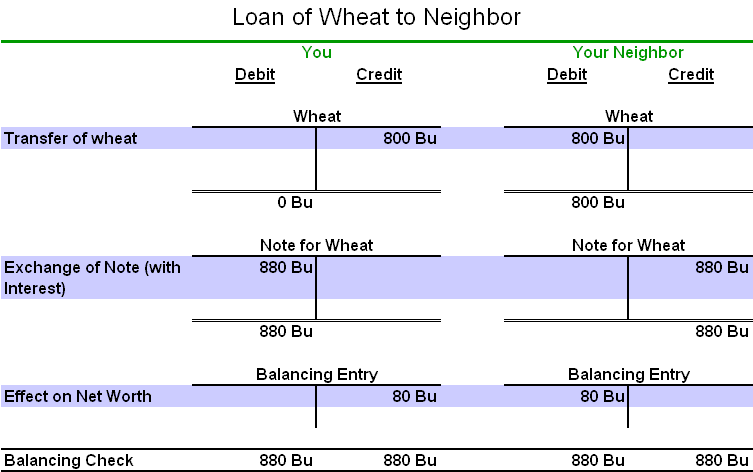The Free Market Center
The Free Market Center

This table shows a record of your loan of wheat to your neighbor. First, I'll explain the entries for You:
You
Your Neighbor records his side of the transaction with the following entries:
Your Neighbor
I have included two items in this chart to demonstrate that the sources and uses balance. First, I have set up a T-account titled Balancing Entry, which I use to consolidate balancing entries that do not appear in the featured accounts. (To conserve web page space, I have featured only a few relevant accounts.) Second, I have included an item called Balancing Check. This row contains sums of the debit and credit entries in each column to assure that total debits equal total credits.
In later examples of economic transactions, I will use the same format used in this table. The examples will become more complex, but if you follow them in sequence, they should remain clear. Because I will add information progressively to these charts, I will highlight the current entries, in the same manner as I have done above.
Your neighbor now has the 800 bushels of wheat, and you have zero bushels of wheat. You have a note receivable for 880 bushels of wheat (of that amount 80 bushels of wheat consists of interest, we'll discuss that later), and your neighbor has a note payable for 880 bushels of wheat.
Notice a couple of things:
Sources (credits) and uses (debits) for this transaction balance (equal).
The total amount of wheat neither increases nor decreases as a result of this transaction. (This point will become important later.)
This personal loan example serves two objectives:
Now, let's take a closer look at interest.
© 2010—2020 The Free Market Center & James B. Berger. All rights reserved.
To contact Jim Berger, e-mail: